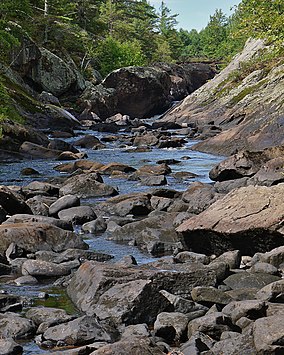Queen Elizabeth II Wildlands Provincial Park
| Queen Elizabeth II Wildlands Provincial Park | |
|---|---|
|
IUCN category II (national park)
|
|

Below the Victoria Falls.
|
|
| Location | Ontario, Canada |
| Nearest city | Minden, Ontario |
| Coordinates | 44°50′0″N 78°56′0″W / 44.83333°N 78.93333°WCoordinates: 44°50′0″N 78°56′0″W / 44.83333°N 78.93333°W |
| Area | 335 km2 (129 sq mi) |
| Established | May 2002 |
| Governing body | Ontario Parks |
The Queen Elizabeth II Wildlands Provincial Park is a provincial park in south-central Ontario, between Gravenhurst and Minden. The park, named for Queen Elizabeth II, Queen of Canada, is 33,505 hectares in size, making it the second largest park south of Algonquin Park (after Kawartha Highlands Provincial Park), but it has a fragmented shape as a result of many private lands within its boundary.
It was originally known as Dalton Digby Wildlands Provincial Park, after the two townships it encompassed, before being renamed on October 9, 2002, to commemorate Queen Elizabeth II's Golden Jubilee visit to Ontario. It fulfilled a promise by the then-Conservative government of Ontario to name a new provincial park in her honour.
The park is one of the largest and least developed natural areas south of Algonquin Park. It protects an ecological diverse and biologically significant area with more than 50 vegetation patterns. The park has a low rolling topography which includes organic soils, flat sandy deposits, wetlands, bare bedrock plain and bare bedrock uplands with shallow soil patches, characterized by numerous rock ridges, including scenic cliffs and gorges, separating dozens of small lakes, rivers and streams.
This vast area was once covered with forest and deeper soils prior to the logging era. Following logging, devastating forest fires swept through the area burning off the shallow organic soils leading to severe soil erosion and barren rock surfaces. Many lakes were filled, or partly filled with sediment, and have become marshes. There are a few islands in the various lakes that escaped the fires, and accordingly remain with deeper soil and much larger trees that stand out boldly in the otherwise low-relief terrain. For many years, this region was known as 'The Burnt Lands'.
The park contains numerous outdoor recreation opportunities including 6 major canoe routes, the Ganaraska Hiking Trail Wilderness Section, remote fly-in fishing camps and a vast network of ATV and snowmobile trails.
...
Wikipedia

